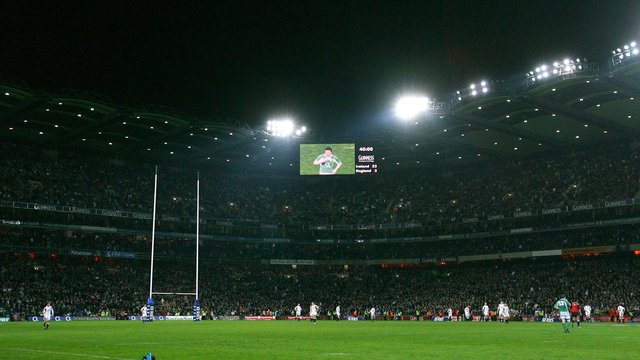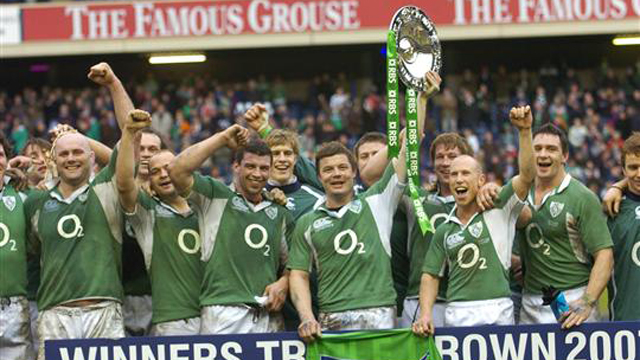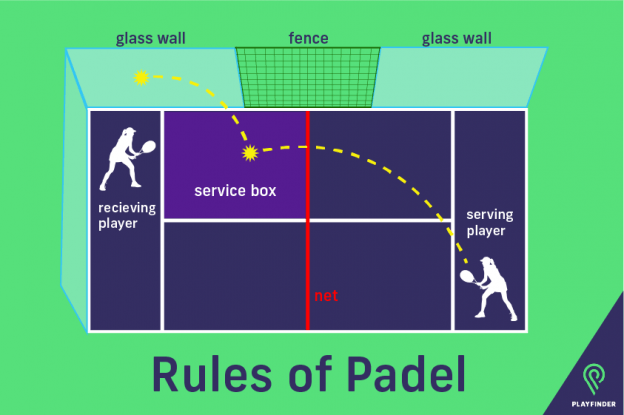Defining Moment: Croke Park opens it’s doors to Rugby
9 October 2015 • By - Finn Mongey
The 2007 Six Nations Championship brought with it a defining moment in the organisation and history of Irish sport. With Lansdowne road under redevelopment the national football and rugby teams were left temporarily homeless. An interim venue was needed and Croke Park seemed the obvious choice but history had proven that Croke Park was not always open to rival sports. In 2005 the GAA added a temporary amendment to their longstanding Rule 42. The rule disallowed other sports being played on GAA grounds but after a vote it was decided that on certain occasions the rule could be overruled.
Croke Park Open To Rugby

The IRFU needed a venue for the country’s 6 Nations games and an agreement was reached for Croke Park to host them. While American football and Boxing matches, including one featuring Muhammad Ali, had taken place in Croker before the six nations would be the first time that a ‘rival’ sport would be allowed into GAA headquarters. Traditionally Soccer and Rugby are considered rival sports to the GAA. The first game for the Irish rugby team at Croke Park was against France, a game that Ireland lost 17-20, however it was Ireland’s second 2007 Six Nations game that created the biggest sense of both occasion and controversy. Ireland were set to face England on the 24th of February 2007.
There was opposition from some groups before the game citing historical and political events in protest of the stadium being used to host the clash with the English Rugby team. Much focus was around whether the English national anthem should be played in the stadium where British security forces had shot and killed Irish civilians in the ‘Bloody Sunday’ shootings of 1920. Memories of trouble during a Republic of Ireland vs England international football friendly in Lansdowne road in 1995 were also in peoples minds. On that night a group of English ‘supporters’ rioted, tearing seats from the stadium and throwing them at spectators beneath. The game was preceded by abuse and disrespect during the respective national anthems from certain sections of fans. The match was abandoned and those causing the trouble were rightly condemned by both the English FA and the FAI.
Regardless of the worries of these groups the game would go ahead. There was a palpable tension in the air of Croke Park as 83,000 fans of the teams got ready for kick off, as well as the realization that however the day unfolded this would be a moment for the history books. The English national anthem was up first and all sections of the crowd remained respectful throughout. The Irish crowd and team then responded with spine tingling renditions of the two Irish anthems, Amhran na bhFiann and Ireland’s Call. Both of the Irish anthems seemed to represent so much of the feeling and narrative around the occasion.
Croke Park is no stranger to Amhran na Bhfiann, the anthem of the Republic of Ireland, as the song is regularly played at the stadium before GAA games, it’s lyrics sung in Ireland’s native language. The resounding rendition of it that day reached volumes similar to pre game anthems before an All Ireland Final. Ireland’s second anthem Ireland’s Call, written as an anthem for the combined island of Ireland, was not short of significance on the day either. Its lyrics and very origin reflected the politics of the island and also the occasion of Croke Park and the GAA opening it’s doors and standing beside another national sporting body, the IRFU.
The emotions on hand were clear on the day and as the Croke Park crowd broke into the Fields of Athenry the game got underway. Regardless of the sport Ireland vs England is a big rivalry to fans, the added politics around the venue and game this time added weight to the occasion. England had had the best of the competitions between the sides throughout the 90s but Ireland’s form against their neighbours across the water had been much better of the two in recent years.
Ireland rose to the challenge on the day but it was England who were the first on the scoreboard courtesy of a Johnny Wilkinson penalty. Ireland’s Ronan O’Gara kicked over at the Hill 16 end three times in reply giving Ireland a 6 point lead after half an hour. Despite slippery conditions the Irish team controlled much of the game and England struggled to cope with the home sides quick ball movement. The hosts had their first try when, Peter Stringer, Gordon D’Arcy, and Brian O’Driscoll combined deft passes to create an easy opening for Girvan Dempsey to touch the ball down for the score.
The home crowd again erupted with noise after an unfair airborne challenge on Dempsey from Magnus Lund. The added intensity from the stand seemed to fuel Irish resolve. It was the team in green who dominated the scrum in the physical game and this lead to the opportunity for David Wallace to land Ireland’s second try of the afternoon, leading to a 23-3 halftime score in Ireland’s advantage.

England improved at the start of the second half, converting a try and penalty to narrow the gap to 23-13. O’Gara knocked over again to restore a 13 point lead but England were looking more and more organised and finally started to answer Irish width and physicality. Perhaps the stadium itself was influencing the game somehow, twice Ronan O’Gara played GAA-esque high cross field passes that were collected in the air, the latter of which led to a try for Shane Horgan. The result was beyond doubt late on when Isaac boss sped in to intercept a poor English pass and sprinted home for a try. Ireland ran out 43-13 winners and Croke Park had new piece of history.
Ireland went on to win the triple crown but narrowly lose out on points to France for the 6 Nations Championship. The following month The Republic of Ireland international football team lined out at Croke Park for the first time. In 2010 the GAA chose to keep the temporary amendment in place allowing them to use Croke Park for non GAA sports. The match on the 24th of February 2007 was not just a sign of how good the Irish rugby team could perform it also went a long way towards setting a precedent and principle for the sporting community and it may also be a defining moment in the modernisation of the GAA. History should not be forgotten but neither should it be dwelled on too much. New landmarks are made every day and in terms of Irish Sport that day will live on for so many reasons, positive reasons. GAA and Rugby stood together and shoulder to shoulder they answered Ireland’s call.

Croke Park is one of the countries best venues. To find some of Dublin’s other top Rugby spots just try Playfinder.




